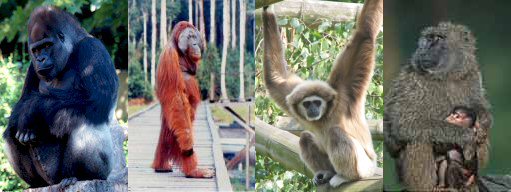Mitochondrial DNA Evolution, Longevity and Disease-Causing Mutations
While the number of sequenced vertebrate genomes is still limited, several mitochondrial genomes, also called mitochondrial DNA (mtDNA), have been sequenced. For instance, a list of metazoan mitochondrial genomes is available at the NCBI, including many vertebrate genomes. So far, the mtDNA has been primarily used in molecular phylogenetics to reconstruct the phylogeny of species and in population genetics. Because mitochondria have been associated with ageing, however, we tried to relate mitochondrial evolution to ageing and longevity in primates.

Image sources: baboon © 2001 Don Getty; gorilla © 2001 John White; orangutan © 1990 Michael Charters; gibbon from Wikimedia Commons.
In this page you will find the results derived from the multiple species comparison of mitochondrial genomes, including the supplementary material, previously described in:
de Magalhaes, JP (2005) Human disease-associated mitochondrial mutations fixed in nonhuman primates. Journal of Molecular Evolution 61:491-497.
Our approach involved the use of positions in the human genome that have been previously associated with human diseases. Diseases associated with the mtDNA can be retrieved from MITOMAP and OMIM. Disease-causing positions conserved in nonhuman primates may help us understand the evolution of disease and maybe even the evolution of longevity and ageing.
In brief, this work resulted in the identification of several mitochondrial genes in which the wild-type allele in non-human primates is a disease-causing allele in humans. While the majority of these results can be explained by secondary compensatory changes, some of them may be linked to the evolution of human longevity and intelligence, indicating a general pattern of selection on longevity in the course of evolution of the human mitochondrion.
Raw results:
- animals_aln.zip, zipped file with ClustalW multiple alignments of mtDNA genes from different vertebrate species.
- primates_aln.zip, zipped file with ClustalW multiple alignments of mtDNA genes from different primates.
Primate comparisons:
- FDDAMs.zip, zipped file with Excel table listing all FDDAMs we found on non-human primates.
- phylogeny.dnd, ClustalW-derived phylogeny of primates based on 12S and 16S rRNA. In PHYLIP format.
- primates.gif, primate phylogeny for the species used in this work based on a number of other works.
- overall_stats.txt, overall comparison of primate mtDNA.

